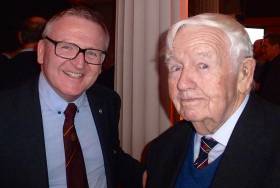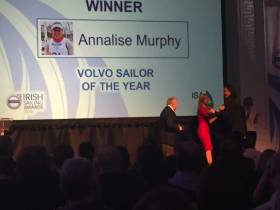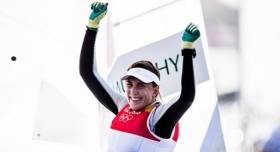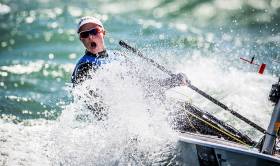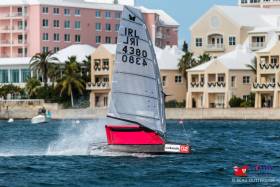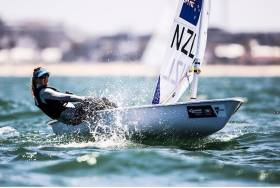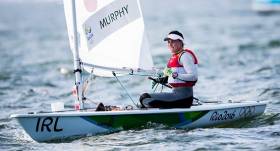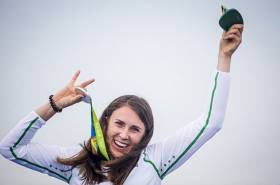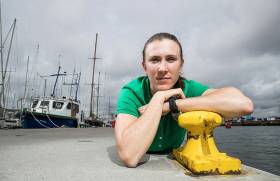Displaying items by tag: Annalise Murphy
All Ireland Gets Together for Sailing Celebration (Photo Gallery of the Sailor of the Year Awards Here)
In public perception terms, sailing had never been higher on the scale of national interest in Ireland than it was in August 2016 when Annalise Murphy’s Olympic Silver Medal victory had an entire nation and its widespread diaspora on the edge of their seats as the final seconds were sailed out in the Medals Race at Rio writes W M Nixon.
But popular attention is a very fickle thing which has now turned to other matters. And with Annalise Murphy since being garlanded with well-earned major national awards under just about every category you could think of, there wasn’t undue concern that the biggest non-surprise for a long time – her elevation to become the Volvo Sailor of the Year 2016 – would simply be taken for granted, and as such, would be regarded as non-news by mainstream media.
So whether it was a mature acceptance of this reality by sailing’s organizers, or whether or not it was just pure serendipity, is neither here nor there. But the fact is that holding the awards ceremony on the last Friday night of January in Dublin may have been the sentence of death of terms of popular news coverage. But for the true faithful of the sailing community from every last corner of Ireland, it was the perfect opportunity for an extraordinarily diverse crowd of people to gather and celebrate their sport in all its forms, and hail their heroes.
Of course the ultimate spotlights were on our supreme award winner Annalise Murphy, and the Youth Sailor of the Year Ewan MacMahon. But with other youth awards, training centre awards, and the very elastically-interpreted Afloat.ie “Sailor of the Month” awards with 27 winners coming into focus, that same spotlight shone brightly if briefly on remarkable achievements in every part of Ireland and abroad, all of them contributing to the fabulous tapestry which is Ireland’s world of boats.
Normally the world of boats and sailing is well aware that it is a minority sport. But on Friday night, it wasn’t a case of it briefly becoming a majority sport. It was the only sport. The camaraderie was palpable. The shared enthusiasm was energising. And the way that people from near and far instantly connected was heartening to behold.
For me, it was summed up by one brief but eloquent encounter. I was talking with Ted Crosbie, who was Admiral of the Royal Cork in 1984-86, and long before that he was the All Ireland Helmsmans Champion, racing in IDRA 14s in 1950. He was there to see his grand-daughter Sophie receive proper recognition for her achievements in Topper racing. As we chatted, Peter Ryan of the National YC hove into view with his shipmate Stephen Tudor of Pwllheli in North Wales, whose overall victory in the ISORA Championship 2016 with his J/109 made him Afloat.ie “Sailor of the Month” for September.
The fact that a top Welsh skipper should win an Irish Sailor of the Month award says all that needs to be said about the creative flexibility of the Afloat system. But equally, here were two top sailors from very different places and backgrounds and generations instantly hitting it off in their shared joy in our sport. The divine spark was undoubtedly present. It was that kind of night.
Olympic Silver Medallist Annalise Murphy Is Irish Sailor Of The Year 2016 (Updated with Photo Gallery)
#SailorOfTheYear – Olympic hero Annalise Murphy has been named Afloat Irish Sailor of the Year for 2016.
August’s Sailor of the Month for her silver medal victory at Rio 2016 was presented with her prize by Irish Sailing Association (ISA) president David Lovegrove at the Volvo Irish Sailing Awards gala in Dublin’s RDS Concert Hall this evening (Friday 27 January).
Murphy was saluted by more than 300 of her fellow sailors, one of Irish sailing’s largest ever turnouts, for her Olympic triumph in the Laser Radial class – Ireland’s best achievement in sailing at the Games since David Wilkins and James Wilkinson won the Flying Dutchman silver at Moscow 1980.
That the National Yacht Club stalwart rallied from her heartbreak at London 2012, where she just barely missed out on a bronze medal, with an incredible display on the waters of Guanabara Bay made her success all the sweeter.
As Afloat.ie’s WM Nixon wrote in November, Murphy’s Olympic performance came after a 10-week transformation on the heels of a poor showing at the 2016 Worlds in Mexico:
“With her dedicated support team, she ensured that she’d become a hugely improved sailor, a fitter athlete and psychologically in a very good place, as she took on the Olympic challenge on August 8th with a cool confidence which in due course received its proper reward.”
It was an achievement that rightly captured the public’s imagination, too, providing Irish sailing with the greatest mainstream profile it’s enjoyed in years.
It’s already seen her recognised as The Irish Times/Sports Council of Ireland Sportswoman of the Year, Irish Tatler’s Woman of the Year, the Evening Echo’s Sports Star of the Year, and as one of Rehab’s two Sportspersons of the Year, not to mention her honorary membership of the Irish Sailing Foundation.
So it was surely to be expected that ‘Our Annalise’ would capture the public vote on Afloat.ie, as well as the votes of the judging panel to earn the prestigious award for a second time upon its 20th anniversary – two decades after first honouring that year’s own Olympic dinghy hero Mark Little, and four years on from her first win in recognition for her stellar efforts in London.
Accepting her prize, Annalise Murphy said: “As a kid I learned that maybe I wasn't the most talented, but I worked the hardest and that’s how I handled my sailing at the Olympics, and that’s what I’d advise all sailors to do now.”
Adding that the standing ovation from the ISA “means a lot to me”, she noted that it was “great to see all the Irish sailing achievements here, and that’s what I love in our great sport. It’s not all about the racing.”
Racing is still very much on Annalise’s agenda, however, with the first stage of her Tokyo 2020 campaign set for the Laser Radial Worlds this August.
Annalise’s accolade must also be seen in light of her fellow deserving nominees, all winners of Afloat.ie’s Sailor of the Month awards, and all of whom made remarkable and significant contributions to Irish sailing throughout the year.
Among them are a GP14 world champion in Shane MacCarthy, a Round Ireland record by Damian Foxall, a pioneering Vendée Globe effort by Enda O’Coineen, and youth sailor and future Olympic medal prospect Finn Lynch.
Irish sailing’s next generation was recognised in its own right on the night with the presentation of the Youth Sailor of the Year prize to Afloat’s racing Sailor of the Month for July, Ewan McMahon, alongside the Training Centre of the Year gong that this year went to Foynes Yacht Club, and two ISA President’s Awards – to Scottish Series racer Colin Moore, and Annalise Murphy's coach Rory Fitzpatrick, the latter of whom said of his eventful year: “It’s not just the Olympic result, it’s the inspiration of Annalise’s discipline routine in Dun Laoghaire that drives on our Laser sailors.”
In his address earlier this evening, ISA president David Lovegrove said he was “bowled over by the achievements of our sailors both at home and abroad.
“For such a small country, we achieve great things and our sailors are truly inspirational ambassadors for our sports and our country. 2016 was a year to make us all proud.”
But Lovegrove also took time to “celebrate the everyday heroes in sailing who don’t always get recognised by awards and cups – the volunteers who dedicate so much time, energy and passion to our sport, and who share their knowledge and expertise with other sailors.
“From the race officials to the instructors, to the coaches and the mark layers, the safety crews and those who carry out a multitude of tasks onshore: we simply could not enjoy sailing the way we do without you. Thank you.”
Hosted by master of ceremonies Fiona Bolger, chief executive of Spinal Injuries Ireland, along with Lovegrove and Afloat.ie’s own WM Nixon, the evening welcomed guests including members of the ISA Olympic and youth sailing squads, training centre principal, national senior and youth champions, class captains and club commodores, and a number of past Olympians and Sailors of the Year.
Great night @Irish_Sailing #Volvosailingawards celebrating our win with Irish Sailor of the Year @Annalise_Murphy pic.twitter.com/ePsrX1QUTy
— Clontarf Y&BC (@TarfYBC) January 27, 2017
Among the crowd were the Royal Cork's Sally O’Leary and her husband Anthony, 2010's Sailor of the Year, who are looking forward to the club’s dinghy fest, along with a band of club mates including Gavin Deane, Admiral John Roche and Rear Admiral Kieran O'Connell and Tom Durcan, who has just welcomed home his son Johnny from Australia, and Ted Crosbie who recently retired from racing.
Brian O’Sullivan and Francis Clifford represented Tralee Bay Sailing Club in the audience this evening, while Paddy Boyd, who was returned from a stint as CEO of Sail Canada, was also present, as were Chris and Sandra Moore of the Dublin Bay Sailing Club, Peter Ryan of ISORA, ICRA Commodore Simon McGibney from Foynes Yacht Club, and Martin McCarthy of Annalise’s home club, the National YC in Dun Laoghaire.
Others in attendance included Cormac Devlin, Cathaoirleach of Dun Laoghaire-Rathdown County Council, and Sport Ireland chief executive John Treacy.
Annalise Cooking Up A Storm At Ballymaloe...
How do you relax after the most intense year of your life, in which the highlight was winning an Olympic Silver Medal racing a Laser Radial at the incredibly demanding sailing venue of Rio de Janeiro? Well, you do something different writes W M Nixon.
Something very different. But anyone who thinks the world-famous 12–week culinary course run by the Allen family at Ballymaloe House in the fertile countryside of East Cork is a relaxing experience really has no idea what a formidable though rewarding challenge it is.
The daily dedication of participants has to be total. And when Annalise Murphy attends the Volvo Sailor of the Year ceremony this Friday night in Dublin, she’ll be only a quarter of the way through the course – she still has nine weeks to go. Yet she’s keen as mustard to get back to work on Monday.
She’s loving it because cooking has always been a favourite hobby, and as her mother Cathy says, she has a genuine natural talent and interest for it. But “doing a Ballymaloe” takes it all to a different level. Anyone who thinks it’s a matter of young ladies swanning around in a sort of finishing school for cuisine is totally mistaken.
Your concentration on food and everything to do with it is expected to be all-excluding. So much so, in fact, that when Annalise was spotted taking a quick look at her mobile phone during lunch, it was confiscated...Did we hear somebody talk about a foodie boot camp?
Annalise Is Sportswoman Of The Year
#Annalise - 2016 draws to a close with another accolade for Ireland’s Olympic hero Annalise Murphy, who was named The Irish Times/Sports Council of Ireland's Sportswoman of the Year in Dublin this afternoon.
The Laser Radial silver medallist was Sportswoman of the Month for August, the same month of that outstanding achievement for Irish sport in Rio de Janeiro.
And that’s not counting her Sailor of the Month nod from Afloat.ie in August, as well as Irish Tatler’s Woman of the Year gong last month, her honorary membership of the Irish Sailing Foundation, the Sports Star of the Year Honour at last night's Echo Sports Awards, and a share of Rehab’s Sportsperson of the Year Award.
The last one she couldn’t accept in person as she enjoyed a well-earned break, dabbling in her ‘hobby’ of Moth sailing at competition level in Bermuda.
That dedication to her craft — which included a 24-hour whirlwind round trip to bring home her medal-winning dinghy — is what we’ve come to expect from our Annalise over the years.
And this latest award shows how the rest of Ireland’s sporting world is catching on. Well done, Annalise!
More from David O'Brien in the Irish Times HERE
Bouwmeester Wins at Sailing World Cup, Rindom Second
Ireland's Laser Radial Olympic medalist Annalise Murphy who was competing at a Moth event in Bermuda lat week will have been keeping a close eye on the Sailing World Cup Final in Melbourne, Australia where her Radial competitors were in action for the first time since Rio.
It was advantage to Rio 2016 Olympic gold medallist Marit Bouwmeester (NED) in the Laser Radial fleet heading into the Medal Race. The Dutch racer took a 12-point lead over Rio 2016 bronze medallist Anne-Marie Rindom (DEN) into the final day and played her cards perfectly to walk away with World Cup gold.
Bouwmeester stayed close to Rindom, remaining risk free and allowing the Dane to win which confirmed Boumeester's gold medal and Rindom's silver.
"I should have been a bit more aggressive to win the race,” said Bouwmeester. "I thought if I stayed close to Anne-Marie I would be fine. I don't think I sailed my quickest but I'm happy to be here and finish the year off with a win. I'm going to have a nice break, put some proper work in and then I'll be back next year.”
Emma Plasschaert (BEL) overhauled Silvia Zennaro (ITA) to complete the podium.
Annalise Murphy & Her Foiling Moth At Full Speed in Bermuda (VIDEO)
Annalise Murphy picked up another well deserved reward at the weekend when she shared the REHAB Sportsperson of the Year Award at the weekend. The Dun Laoghaire Olympic Silver medalist couldn't be there in person to pick her award at the Dublin ceremony because as soon as she arrived home her medal winning Laser she jetted off to Bermuda to sail her foiling Moth where there's been plenty of action over the last few days. Just look at Annalise in the pink Moth go...
Annalise Murphy Absent For Rio Radial Replay at Sailing World Cup Final, Melbourne
Ireland's Annalise Murphy, who is flying her Moth dinghy at high speed in Bermuda, is not contesting this week's Sailing World Cup final in Melbourne but apart from the Irish silver medalists absence competition in Australian waters looks as intense as Rio at the sharp end of the 19–boat Laser Radial fleet. Gold medallist Marit Bouwmeester (NED) is favoured to win. The Dutch champion controlled a lot of the field at the Rio 2016 Olympic Games with an astute, professional display and quickly turned her attention to Tokyo 2020 immediately after winning Rio gold, heading to Japan to start familiarising herself with the next Olympic waters.
Danish Rio bronze medallist Anne-Marie Rindom will face off against Bouwmeester again, this time hoping to upset the Dutch party. Joining the Rio medallists in the fleet is current Laser Radial Youth World Champion and Rio Olympian Maria Erdi of Hungary who will warm up for the Youth Sailing World Championships by competing at the World Cup Final.
Great Britain's two-time Olympian Alison Young was down to race in Melbourne but sustained an ankle injury in the lead up and withdrew.
Annalise Brings Home Olympic Medal-Winning Laser Dinghy
#Annalise - After a whirlwind 24-hour round trip by ferry and road to Britain this week, Annalise Murphy has returned to Ireland with the boat she sailed to a silver medal at this summer’s Olympic Games in Rio.
The idea of taking ownership of the historic Laser Radial dinghy was first mooted by our own WM Nixon back in August, and quickly gathered pace as Jim Cusask talked up the notion for the Irish Independent.
Here’s hoping Annalise and team have plans to let the public get a closer look at the dinghy she raced to success on Guanabara Bay at Rio 2016.
A 24hr round trip to @LaserPerform to pick up my boat from the Olympics! @Irish_Ferries got me safely home at 6am this morning! pic.twitter.com/WIH8iTFyBE
— Annalise Murphy (@Annalise_Murphy) November 29, 2016
Irish Sailing Foundation Honours Olympic Hero Annalise Murphy
#ISF - Rio silver medallist Annalise Murphy is now an honorary member of the Irish Sailing Foundation (ISF) following her incredible Olympic success this past summer.
The announcement comes as the ISF, the new investment support structure for Ireland’s high performance sailing programme, celebrates a year of achievement at every level of competition.
Indeed, Murphy’s medal win wasn’t the only result for Irish sailing in August, with fellow Team IRL members Ryan Seaton and Matt McGovern making their medal race in a final hurrah before their recent split, Andrea Brewster and Saskia Tidey just missing out on their skiff final, and Finn Lynch putting in a strong performance as the youngest in his class in preparation for a medal challenge at Tokyo 2020.
Beyond the Olympics, August was a good month for Johnny Durcan, Fionn Conway and Ronan Walsh, who took second, third and fourth places respectively in the UK Laser Nationals, while Johnny’s twin Harry Durcan, with Harry Whittaker, won the UK 29er Nationals in Torbay, and Tom Higgins sailed the first Irish boat to win the Volvo Gill Optimist National.
Earlier in the summer, there was success for Ireland’s girls in the Topper Worlds at Ballyholme, as Sophie Crosbie, Ella Hemeryck and Jenna McCarlie claimed the podium from gold to silver in that order, though the boys didn’t fare too badly either, with Michael Carroll in fourth and Jack Fahy sixth.
Elsewhere, at the Laser Worlds in Dublin, Nicole Hemeryck — sister of Ella — placed seventh in the U19 girls competition, while Ewan McMahon was second among the boys. Nicole was also second in the under 19s( 13th overall) at the under 21 worlds in Kiel, Germany.
And even earlier in the year, there was a bronze medal for Dougie Elmes and Colin O'Sullivan at the ISAF 420 Youth Worlds in Malaysia, the first ever podium for Ireland in that competition.
Currently all development teams in the Laser, Laser Radial and 49er have moved to Cadiz to escape the cold ahead of January’s annual World Cup in Miami, with further training camps to follow in Spain and Malta in February and March.
But the year isn’t over yet, as Ireland will be represented by Nicole Hemeryck and Johnny Durcan at the Youth Worlds in New Zealand from 14-20 December.
Looking at the longer term, ISA performance director James O’Callaghan will be on hand at a Performance Pathway information meeting at the Royal Cork this Wednesday 30 November where he will discuss, among other things, the results of his recent fact-finding mission to Tokyo.
O’Callaghan was gathering intel on the sailing venue at Enoshima with a view to Team IRL establishing an early base there — identified as one of the keys to Annalise’s medal finish this summer. That will be especially important at Tokyo 2020, where temperatures and humidity will be significantly higher than they were in Rio.
Bikes, Moths, Labradors & Handbags Among Annalise Murphy's Most Treasured Possessions
Olympic silver medalist Annalise Murphy has told Ireland's Marketing magazine she is happiest sailing her foiling Moth dinghy. 'I’ve had some nasty crashes in it but there’s no other women in the world really sailing it, so I’m delighted to be leading the charge', she told the publication.
The National Yacht Club sailor has deservedly been picking up lots of awards for her summer achievement in Rio. She won Tatler's Irish Woman of the Year award and next weekend she'll be in City West for the '2016 People of the Year Awards'. Annalise shortlisted for Afloat's Sailor of the Year Awards in January.
In Marketing magazine's '20 Questions' interview the solo sailor also reveals that apart from family and her Moth dinghy, bikes, Labradors and handbags are her most treasured possessions. Read the full interview here.


























